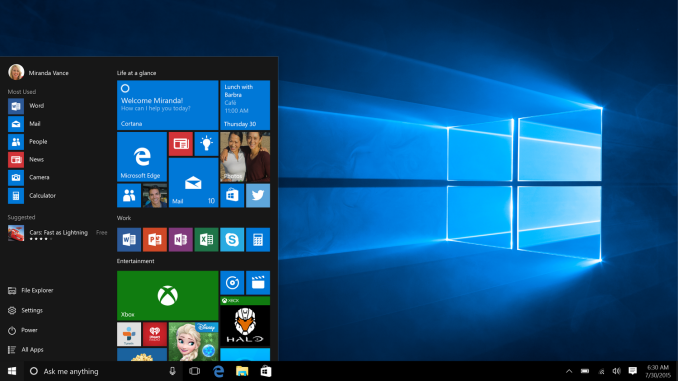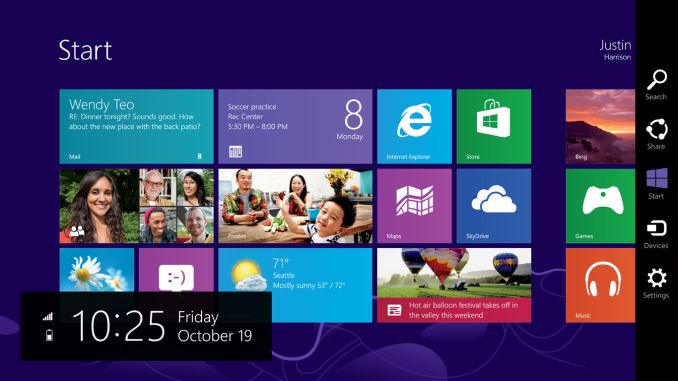The Windows 10 Review: The Old & New Face of Windows
by Brett Howse on August 25, 2015 8:00 AM EST- Posted in
- Operating Systems
- Microsoft
- Windows 10

Let’s flash back to 2012. About three years ago, Windows 8, the last major release of Microsoft’s ubiquitous operating system, was released to manufacturers. This was to be Microsoft’s most ambitious release yet. Traditional PC sales were in decline, and more personal devices such as the iPad tablet were poised to end the dominant PC platform. Microsoft’s response to this was to change Windows more than in any previous release, in a bid to make it usable with the tablet form factor. Windows 8 launched in October 2012 to much fanfare.
There was much fanfare, but little in the way of sales. Yes, Microsoft did sell many copies of Windows 8, but it did not help the declining PC market rebound. Windows 8 came to be with a touch first interface, with a new Start Screen replacing the traditional Start Menu, and a new breed of Windows 8 apps, which run on the WinRT framework. These WinRT apps have been named many things over the past three years, starting with Metro apps. A trademark dispute ended that naming scheme though, and over time they have morphed from full screen apps to universal apps to Windows Store apps, and practically none of them were able to rival the older Win32 platform in popularity or productivity.
Windows 8 did bring some great features to Windows, but they were overshadowed by the major design shift which, while good as a touch based operating system, alienated many who still used Windows on a traditional desktop or notebook. The Start Screen was a big turn off to many people, and full screen apps were not very efficient on a large screen display. Even the multitasking in Windows 8 was less than ideal, with the initial release only allowing two Windows Store apps to be open at any one time, and the second was relegated to a small side bar.
Microsoft’s own faith in Windows 8 was clearly not strong. Only a couple of weeks after Windows 8 launched, they unceremoniously dumped the project head Steven Sinofsky from the company, and spent the next two years trying to make Windows 8 more usable on traditional mouse and keyboard type machines, which were the vast majority of Windows devices in the hands of users. Windows 8.1 arrived and fixed some of the key issues with Windows 8, and 8.1 Update launched with the ability to boot to the desktop, and avoid the touch interface almost completely if you wanted to.
 Windows 10 Start Menu and Desktop view
Windows 10 Start Menu and Desktop view
When looking at Windows 10, I think it is pretty important to look back over the last three years, because none of this is ever built or designed in a vacuum. Microsoft has a huge number of devices running Windows, but a large majority of them are running Windows 7, which was an evolutionary desktop upgrade. Windows 8 struggled to ever take over any of that usage share. Windows 10 is Microsoft’s attempt to bridge the divide. Windows 7 is used by hundreds of millions of people, but its touch support is practically zero. Windows 8 works well in a touch scenario, but is not ideal for keyboard and mouse based devices. Windows 10 promises to be the version of Windows which bridges this gap.
Windows 10 brings about as much change as Windows 8 did, but in almost all cases it is going to be appreciated by users rather than avoided. It will run on a dizzying number of device types, including the traditional desktop, notebook, tablet, two-in-one, phone, IoT, Raspberry Pi, Hololens, Surface Hub, and even Xbox One. What it will bring to each of those device types is not the single interface that Windows 8 pushed on the desktop, but a unified app platform. Each device type will have its own interface, but the underlying app platform will allow developers to target a huge number of devices. And developer buy-in is the one thing Microsoft needs more than any other in order to make this vision succeed. For all of Windows 8’s quirks, it was really the lack of quality apps in the Windows Store which was the one hurdle Microsoft could not code around. Only time will tell whether or not the new model succeeds where the old one failed, but at the beginning of the life of Windows 10 we can go through all aspects of it and see what’s new, what’s changed, and how it fits in on today’s devices.











293 Comments
View All Comments
Notmyusualid - Tuesday, August 25, 2015 - link
+1Victor84 - Tuesday, August 25, 2015 - link
I upgraded from Windows 8 but ran into so many bugs and strange problems that I downgraded after a couple of hours.cjs150 - Tuesday, August 25, 2015 - link
I have been using w10 for a couple of weeks now. It feels a bit quicker than w8, but somewhat to my surprise I find I am missing the live tiles start screen.Multiple virtual desktops is a wonderful, and long overdue, feature. Edge is very nice (but I still went back to Chrome).
Now the bad points:
1. File explorer. Other than cosmetic changes it has not been overhauled for decades and it shows
2. Groove music, Brett may like it, I don't. It would not update my music collection without logging in to my Microsoft account (which I do not use except when forced to) when I ticked box to log into that application only, W10 ignored me switched my entire account to the Microsoft account (which took ages to find the disconnect option). Its ability to correctly tag my music collection (sadly all WAV) is the same as media player, which is to say total crap. It is a big waste of space.
3. Windows Media Centre - bring it back I miss it!
4. New start menu. I got used to not having it in w8, the new version is clunky, bug ridden and I am sure that the use of live tiles is solely because MS is too embarrassed to ditch them. I guess I will be buying Stardock start10 or similar third party replacement.
Overall a nice upgrade from Vista but not really worth it for w7 or 8
chrome_slinky - Wednesday, August 26, 2015 - link
Tiles are not because of embarrassment. Tiles are there because of hubris. They want you to have things their way, whether you like it or not.sorten - Tuesday, August 25, 2015 - link
"Windows 8 works well in a touch scenario, but is not ideal for keyboard and mouse based devices."Brett, this is an interesting comment. Which mouse and keyboard features weren't working for you in Windows 8? I used Windows 8 on my home desktop from beta and my mouse and keyboard worked fine. I stopped using the Start button with Windows Vista because the search feature is much quicker, but even the missing Start button was fixable with 3rd party options.
Oh well, on to Windows 10. Hopefully people try it before condemning it. Based on the tinfoil hat comments above I'm guessing they won't.
Brett Howse - Tuesday, August 25, 2015 - link
I mean let's not open this debate again, but yes it works with a keyboard and mouse, but it is less than productive when you are in Windows Explorer, double click a photo to look at it, and a full screen photos app pops up and you can't see what you are doing anymore. There were so many of these examples. Everything worked yes, but productivity was not what it needed to be on that form factor.I mean think about out of the box Windows 8 and trying to reference a PDF. Windows Reader would open it full screen, and you would have to snap the desktop to half of the screen to work with it, and muck around with your windows. The solution that we all did was to stop using the new apps and go back to things like Adobe Reader on the desktop, but that's not a win for the platform and its new app model. If the new app model is not one that everyone uses, then you will never get quality apps built for it because it would only be available for a subset of users.
chrome_slinky - Wednesday, August 26, 2015 - link
I got rid of it 3 days after launch, as I had been running it since February, and could take the irk no more. I would LOVE to see someone compile a list of the places where a right click has always produced a result, and no longer does anything - far from the BS about how the device will dictate the interface, which, if you think at all, means that desktop users should see no change in the way it works for them. That, of course, is NOT the case, proving the lie from Microshaft, and also showing they are either incapable or too lazy to implement things they had said they were going to.Notmyusualid - Tuesday, August 25, 2015 - link
PROUD 'Tin foil hatter' here...chrome_slinky - Wednesday, August 26, 2015 - link
Paid troll?Michael Bay - Wednesday, August 26, 2015 - link
Your envy is obvious.